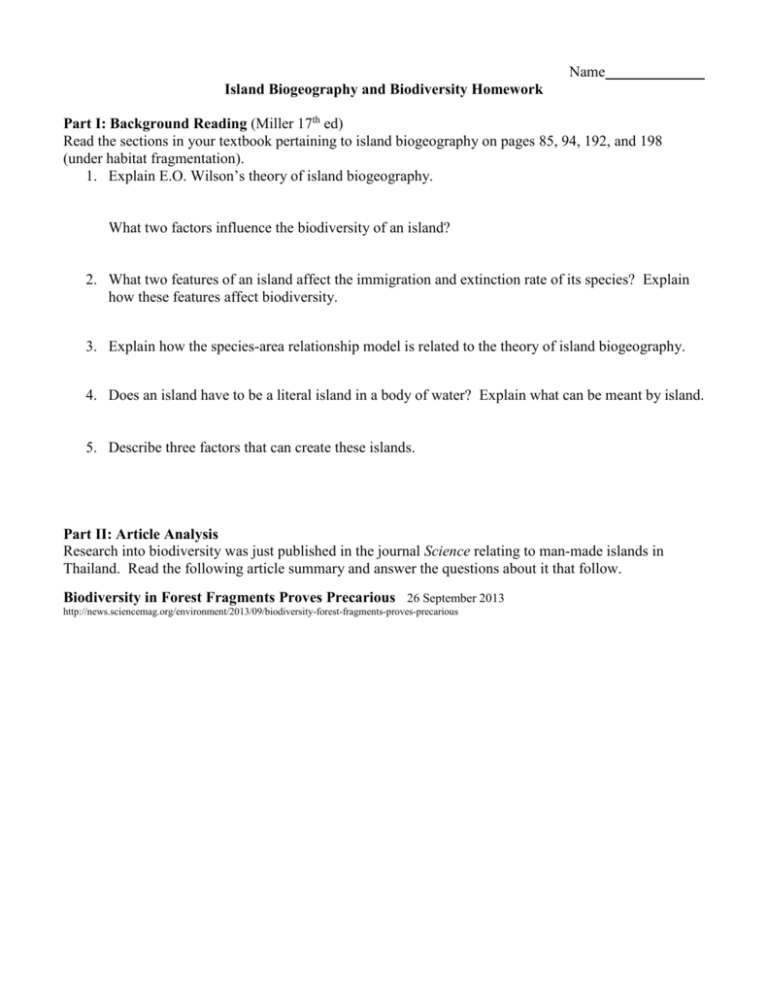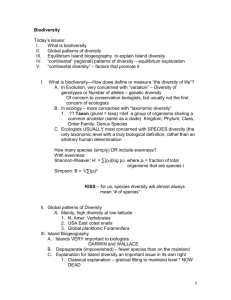Island Biogeography HW Activity
advertisement

Name Island Biogeography and Biodiversity Homework Part I: Background Reading (Miller 17th ed) Read the sections in your textbook pertaining to island biogeography on pages 85, 94, 192, and 198 (under habitat fragmentation). 1. Explain E.O. Wilson’s theory of island biogeography. What two factors influence the biodiversity of an island? 2. What two features of an island affect the immigration and extinction rate of its species? Explain how these features affect biodiversity. 3. Explain how the species-area relationship model is related to the theory of island biogeography. 4. Does an island have to be a literal island in a body of water? Explain what can be meant by island. 5. Describe three factors that can create these islands. Part II: Article Analysis Research into biodiversity was just published in the journal Science relating to man-made islands in Thailand. Read the following article summary and answer the questions about it that follow. Biodiversity in Forest Fragments Proves Precarious 26 September 2013 http://news.sciencemag.org/environment/2013/09/biodiversity-forest-fragments-proves-precarious Anthony Lynam; (inset) Luke Gibson Going, going … Small mammal species have disappeared more quickly than expected from the forest fragments on islands created by flooding in southern Thailand. Populations of surviving species, such as this moonrat (inset), have plummeted. As deforestation accelerates around the world, ecologists have increasingly pinned their hopes of preserving biodiversity on nurturing the isolated patches of forest often left behind. But new research suggests that small mammal species native to these forest fragments are at greater risk of extinction than previously thought. The filling of the Chiew Larn Reservoir in southern Thailand in 1986 and 1987 created more than 100 islands and presented a rare opportunity to study the effects of sudden isolation on small-mammal communities. In the early 1990s, a team led by population geneticist David Woodruff of the University of California, San Diego, set traps to survey small mammals on 12 of the islands, ranging in size from 0.3 to 56.3 hectares. They found that after 5 to 7 years of isolation, the three biggest islands were still home to seven to 12 species of mice, rats, squirrels, and shrews. The range of species was similar to that found in a large, undisturbed forest on the nearby mainland. On the small islands, however, the researchers found just one to three species, indicating a rapid decline in diversity, presumably because the islands were too small to sustain animal communities. Ecologist Luke Gibson of the National University of Singapore and colleagues revisited those islands plus four more in 2012 and 2013 to repeat the surveys, with some dramatic results. Six of 12 species present in the early 1990s, including the pencil-tailed tree mouse and the red spiny rat, have apparently disappeared. Five other species have declined dramatically. For example, the 1993 survey turned up 47 common tree shrews, but only one was found in 2013. "We documented the near-complete extinction of an entire group of animals," Gibson says. In contrast, Malayan field rat numbers exploded, from 77 in 1992 to 289 in 2013. This rat is not normally found in the region’s undisturbed forests but likely migrated to the islands from villages and agricultural areas after inundation. It now dominates the islands but is rare in the intact forests of the nearby mainland. In the absence of other obvious causes, the researchers blame the loss of species on fragmentation and the impact of the invasive rat. This one-two punch "underscores a dire need to maintain large intact forest blocks to sustain tropical biodiversity," the authors write today in Science. Gibson adds that the loss of species occurred more quickly than has been reported by other groups studying other sites around the world. "This study makes a valuable contribution in quantifying how fast the extinctions take place—very fast in this case," says Ilkka Hanski, an ecologist at the University of Helsinki. But he notes that the study does not tease out whether the fragmentation or the rat invasion had a greater impact. Robin Chazdon, an ecologist at the University of Connecticut, Storrs, notes that the mechanism by which the invasive rats contributed to the demise of native species—whether they devoured available food or introduced new diseases—is not clear. "These findings are not directly relevant to forest fragments in terrestrial landscapes," where animals from surrounding areas could recolonize the isolated patch, she says. Gibson agrees that it is difficult to separate the impact of forest fragment size from that of the rats. "Our data don't show any direct mechanism," for how the rodents might have tipped the scales against the natives, he says. As for the implications for fragments on large land masses, he argues that these small islands provide "a sign of things to come." For example, he says a recent study of Brazil's Atlantic forests found that 80% of fragments remaining after deforestation are 50 hectares or smaller—about the size of the Thai island samples. Although most forest fragments are not ringed by water, they are nonetheless “increasingly surrounded by intensive agricultural landscapes that often harbor invasive animal species," Gibson says. Beyond preserving large intact forests, he adds, conservation efforts should aim to keep or create forested corridors to link small fragments of important habitat or to connect them to larger forests nearby. Part II Questions to answer: 1. Explain how this forest ecosystem became fragmented. 2. Summarize the scientists findings about biodiversity on the a. Small islands – b. Large islands 3. Make a simple graph of the overall findings by Luke Gibson between the early 1990s and 201213. When you’re answering, if the graph paper breaks over two pages, space down so your graph is on one page only. 4. Make another graph comparing the change in the number of common tree shrews with the Malayan field rats. When you’re answering, if the graph paper breaks over two pages, space down so your graph is on one page only. 5. Explain the two major factors that caused the rapid change to biodiversity. 6. Although the findings of this study are important, what is one difficulty the scientists had in making their data interpretation? Does this invalidate their study? Explain.






